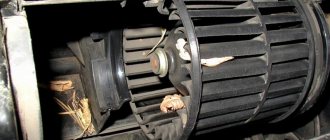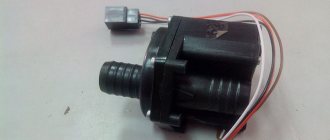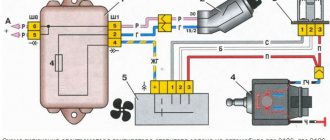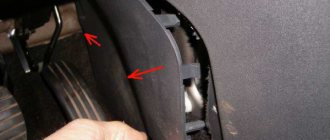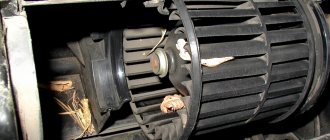replacing the heater motor on a gazelle business
Congratulations to everyone on the miracle machine. Ask the designer to do it himself. I'll tell you everything in order. The resistor electronic motor speed controller is located in the stove body and is cooled by the stove motor. Dust and moisture settle on it, at the end of which its circuit board closes and it burns out completely, and I also took the stove motor with me. The only way to protect against this disaster is to install a filter.
Without a filter, in two or three years everyone will face this disaster. I had a lot of dust on the resistor regulator in half a year, and it just melted all over. There are a lot of repairs for these resistors, but replacing stove motors is still rare.
But this is only for now, the only salvation is this CABIN FILTER, I AM INSTALLING IT FOR MYSELF URGENTLY. Okay, first things first. Photos from your phone, don't swear. We begin to disassemble the torpedo. Next, the torpedo was removed. Here is a motor speed regulator resistor. You can only get to it by removing the torpedo completely.
It completely burned out for me. When replacing it, the motor did not start. They brought a new motor, connected it separately, it works. We began to get to the stove motor. This is a separate song.
You need to remove the iron mount for the heater and dashboard, then disconnect absolutely all the wiring from the entire interior. (I thought terribly that it would never come back together.) We took the stove out of the car, this is what saltwater looks like without a stove.
How to remove the radiator of a gazelle stove?
In winter, the car's heater plays a major role; it supplies the interior of the car with heat, thereby providing a comfortable air temperature for the driver and passengers. The stove in our country plays an integral role in the car. In winter, not only a pleasant temperature in the cabin, but also safety depends on it, since without it our windows fog up or become covered with frost. A stove breakdown in winter is certainly a nasty problem that needs to be solved recently. So, let’s look at the design of the main heater of a gazelle car.
Main heater: 1 – bracket; 2, 4 – damper axis levers; 3 – bracket for fastening the drive rod shells; 5 – clamp; 6, 7, 17 – shells of cable rods; 8, 9 – damper drive racks; 10 – protective casing; 11 – OVU building; 12 – fan cover; 13 – seal; 14 – electric drive connector; 15 – screw; 16 – electric fan; 17 – two brackets for fastening the electric fan flange; 18 – thrust; 19 – heating radiator; 20 – gasket; 21 – cover; 22 – tap; 23 – hose
In most cases, in the summer, we close the tap (pos. 22) so that warm air does not flow into the cabin by gravity. With the onset of cold weather, we forget to turn it on and our stove does not allow heat into the interior. In this case, just open it and enjoy the warmth.
One of the most common problems when the stove
it works, but stops supplying warm air, this is a problem with the cable, the traction is weakened or completely lost.
It is necessary to tighten the cable (pos. 19) so that when fully opened, the cable opens the damper one hundred percent and when fully closed, closes it. If such an operation does not help, then we check the inlet and outlet pipes; if the inlet pipe is warmer than the outlet pipe, then we can conclude that your stove radiator is clogged, it needs to be removed
and cleaned
Heater Gazelle-Business.
Welcome to ChipTuner Forum.
Bashkirov Vladimir
Dear, hello! The Saber Gazelle, her mother, Business, came to me. And the stove would malfunction at least once in my presence! It turned on flawlessly, both after turning off the ignition and after turning off the fan by turning the CV control knob. The fault is hidden. I questioned the driver passionately about the malfunction and found out the following: a) when the fan is not working, the climate control display lights up and icons are displayed. When switching the blowing direction, the gearmotors hum and the dampers move. When you turn the RHF knob, a change in the rotation speed setting is indicated (the fan itself does not spin). b) While driving, if the speed is sufficient, the cabin is warm without a fan. Conclusion: Most likely, the climate control ECU is working. Either the stove fan or the PWM frequency regulator (electronic resistor, so to speak) is faulty.
Since the Gazelle organization decided to change both the resistor and the motor. The panel must be removed for this, as well as for further diagnostics, so we decided to first buy a resistor and a motor.
I found an interesting point. The QC ECU has two connectors, all wires are thin, approximately 0.75. This means that the power wires go directly to the PWM, and from it to the motor. Power comes only to one leg of one connector. When the ignition is turned off, the power disappears. If you touch one of the connector terminals with the probe of the test lamp, the motor starts working immediately at maximum speed. This does not depend on the position of the ignition key, and does not depend on whether the connectors are connected to the QC ECU.
Who has any thoughts?
Added after 10 minutes
Dear, hello! The Saber Gazelle, her mother, Business, came to me. And the stove would malfunction at least once in my presence! It turned on flawlessly, both after turning off the ignition and after turning off the fan by turning the CV control knob. The fault is hidden. I questioned the driver passionately about the malfunction and found out the following: a) when the fan is not working, the climate control display lights up and icons are displayed. When switching the blowing direction, the gearmotors hum and the dampers move. When you turn the RHF knob, a change in the rotation speed setting is indicated (the fan itself does not spin). b) While driving, if the speed is sufficient, the cabin is warm without a fan. Conclusion: Most likely, the climate control ECU is working. Either the stove fan or the PWM frequency regulator (electronic resistor, so to speak) is faulty.
Since the Gazelle organization decided to change both the resistor and the motor. The panel must be removed for this, as well as for further diagnostics, so we decided to first buy a resistor and a motor.
I found an interesting point. The QC ECU has two connectors, all wires are thin, approximately 0.75. This means that the power wires go directly to the PWM, and from it to the motor. Power comes only to one leg of one connector. When the ignition is turned off, the power disappears. If you touch one of the connector terminals with the probe of the test lamp, the motor starts working immediately at maximum speed. This does not depend on the position of the ignition key, and does not depend on whether the connectors are connected to the QC ECU.
Who has any thoughts?
Added after 10 minutes
Conclusion: if it’s not a diesel engine, then you DO NOT need to remove the torpedo, if it’s a stone (kumenns) the mother of Iago 2 people 3-3.5 hours of work (remove the torpedo) BUT with skill, there are 2 tricky screws ******* and his mother YOU WILL REMEMBER his mother-in-law more than once.
What is better: repairing the stove yourself or entrusting it to our specialists?
At first glance, the design is not particularly complicated, and therefore a car owner who has an understanding of the structure of the car can easily cope with the repair on his own. In practice, dismantling the stove without sufficient experience can easily damage adjacent components, thereby causing expensive repairs. Our specialists have already repaired hundreds of stoves on Gazelles of various models, so by contacting our service, you are guaranteed to protect yourself from such troubles.
Symptoms of malfunction
To restore or reset the damper, returning it to a working state, you must first make sure that the fault lies in these elements of the heating system of the GAZelle car.
With the onset of cold weather, many GAZelle car owners note this situation. Staying in place with the heater on, the interior warms up quite well and the car is warm inside. But as soon as the car starts moving and starts driving, all the accumulated heat is gradually blown out, the cabin becomes cold, and the working stove cannot restore the previous temperature.
At the same time, everything works fine, there are no complaints about the electric fan of the furnace equipment, the regulators also work properly.
In a situation like this, when the heater is functioning, but the heat still disappears from the car while driving, there is a high probability that the heater is working, but the damper needs to be repaired or replaced. The repair itself cannot be called complicated, but for comfortable work it is recommended to remove the old or new type of heater casing on which the dampers are located, and replace them under more convenient conditions.
The problem with the old panel and the advantages of the new one
Improvements in the automotive industry bring many positive changes, including improving weaknesses, eliminating factory defects, and improving technical and operational characteristics.
In fact, there are not many complaints about the Gazelle with the old-style panel. Quite functional, informative and of high quality for its time and cost. But if the question concerns such a unit as the heater electric motor, which needs to be removed and replaced with a new one, then the car owners have serious problems.
Compared to the updated version, when it comes to the new panel, it was extremely simple to replace the heater motor if it does not work or does not function correctly. You will clearly see this in the next section.
As for the old panel on the Gazelle, changing the stove motor will be objectively problematic.
In fact, there are two options available.
The first replacement method involves completely removing the entire torpedo. Yes, the work ahead is extremely serious and lengthy. You will need to remove literally everything, including the dashboard, steering wheel, center console, glove box, and disconnect many terminals and wires. The task is not easy, and it is not recommended for a beginner to take it on. This requires the help of one more person.
In the case of an old-style stove, only a few decide to take on the task of replacing an electric fan. Therefore, they often go to specialists with this question, who will change the unit for a certain fee.
At the same time, there is a high probability that the craftsmen themselves will decide to change your faulty electric motor in a somewhat roundabout way. It is not provided in the official instruction manual, but it significantly saves time and effort.
Repair
After everything has been checked and we can say with complete confidence that the faulty element is the heater motor, then only after that should we begin to dismantle the instrument panel, since in order to remove the heater, we need to dismantle the entire dashboard assembly. For this operation we need a set of heads and screwdrivers. To get to the heater, you need to dismantle the entire instrument panel.
- First of all, let’s secure the workplace by disconnecting the positive cable from the battery.
- Remove the side plastic covers.
- Get the speakers in the dashboard.
- Disconnect the instrument panel.
- Remove the side panel covers on the left and right.
- Unscrew the heater control unit with deflectors.
- Remove the deflector located under the windshield.
- Unscrew and remove the glove compartment, which is located below, on the passenger side.
- Next, unscrew the bolts that secure the heater to the car from the engine side.
- Drain the coolant from the engine into a clean container.
- Remove the pipes through which coolant from the engine enters the heater radiator (there will be residual coolant in them; measures must be taken to prevent coolant from leaking into the passenger compartment).
- Then put marks on the electrical wiring terminals (so as not to confuse them during assembly) that fit the devices, and disconnect them.
- Next, unscrew the fasteners that secure the steering column to the dashboard, after which it will rest freely on the driver’s seat.
- Then remove the torpedo (an assistant will be needed for this procedure), removing it from its place, carefully make sure that there are no undisconnected terminals; if any, they need to be disconnected.
- And put the panel on something soft so as not to scratch it.
- Next, we dismantle the iron frame, which is located behind the removed torpedo, and also, together with an assistant, remove it.
- Then we will disconnect the air ducts that come from the stove (it is better to mark or photograph them so as not to confuse them during assembly).
- Now you can start “halving” (unscrew the screws and remove the brackets).
- We take out the electric motor with the impeller. Now you need to check it and understand whether the element is repairable or not. In this case, replacing the motor would be more advisable, since it is impossible to say with certainty how long the repaired motor will last. And if it fails, you will need to do all the above work again.
- After repairing or replacing the motor, we assemble everything in the reverse order. And before final assembly, we check its operation in all modes, and if everything works, we complete the work.
These are the recommendations that can be given if the Gazelle Business stove motor does not work. Of course, it’s unpleasant that because of such a small thing as an electric motor, you have to disassemble the entire dashboard, but without heat in the cabin, driving is uncomfortable and unsafe. You can, of course, contact a service center where they will replace and repair it. But if you have time and experience, then you can carry out all the repairs yourself.
How to replace the motor (fan) of the Gazelle Business stove
It is difficult to imagine a modern car without an interior heater. It makes the trip not only comfortable, but also safe. When driving in the cold season, moisture condenses on cold windows, and movement becomes difficult or completely impossible. To avoid this, warm air from the stove is directed onto the glass, which causes them to heat up and prevent moisture from condensing on them.
Loan 9.9% and installments 0%
How to dismantle the radiator on Gazelles?
In order to diagnose a malfunction of the stove, you must first gain access to the radiator inside the car. On older cars, this operation is extremely simple - in order to remove the radiator, you need to dismantle the central panel of the dashboard, drain the coolant and unscrew two bolts.
On Gazelles Business and older, the sequence of actions is as follows:
- Remove the front passenger seat for maximum access;
- Drain the coolant;
- For an additional stove in the cabin, remove the protective casing and dismantle the radiator;
- For the driver's radiator, unscrew the glove compartment and unscrew the radiator through it.
How the stove works in Gazelle Business
For correct diagnosis and repair, it is important to know the structure and operating principle of the heater, so that at the first sign of a breakdown, you can identify the problem or make repairs, preventing failure of the entire unit as a whole. Most breakdowns can be predicted by subtle signs and their progression can be prevented
To do this, you need to know and understand what any of the components is responsible for and what the meaning of its work is.
Car cooling system
In Gazelle Business, the stove is considered an important part of the engine cooling system. During engine operation, a lot of heat is generated that needs to be removed.
Heat is released due to fuel combustion and from rubbing surfaces. If the heat is not removed, the motor will quickly heat up and break down. The cooling system has 2 circuits (small and large circle), they are divided by a thermostat. When the liquid is cool, it moves in a small circle, and when it warms up, it moves in a large circle. This makes it possible to quickly reach operating temperature and not get too hot. In the warm season, heat is released into the atmosphere, and when cool weather sets in, part of the heat is spent on heating the cabin.
Once we understand how the cooling system does not stop working, we can move on to heating the cabin. The heater circuit on the Gazelle car is similar to the heaters of other cars that have a liquid-cooled engine
Liquid can circulate through the heat exchanger of the heater no matter whether the thermostat is open or not. For better heat supply, the fluid for the stove comes from the hottest part of the engine (from the cylinder head)
Thanks to this, on an engine that has not yet reached operating temperature, pleasant air still comes out of the deflectors. The heater has a valve in its design that either allows liquid to flow into the heating device or discharges it back. And the temperature of the environment leaving the deflectors depends on how much it is open. The valve position is adjusted from the heater control panel. The faucet is equipped with an electric drive that changes the position of the valve. It is also possible to change the blowing intensity and direction from the control panel. The intensity is controlled by a motor with an impeller, the rotation speed of which changes the intensity of the airflow.
Changing the position of the dampers changes the direction of the airflow (to the face, to the legs, to the chest, to the glass). The heated coolant from the engine penetrates through the line into the heater of the stove, causing it to heat up. At this time, air blown by a fan passes through it. Then it passes through air channels, the dampers of which are open. Then the hot air enters the car interior and warms it up. For repair work or diagnostics of breakdowns of this equipment, there is an electrical diagram on which all components of electrical devices are indicated. And in case of breakdowns or incorrect operation of devices, you need to read it in detail in order to understand where it is powered from and how the failed device changes.
When you know the working principle and device, it is much easier to navigate in case of breakdowns. After all, to successfully carry out a repair, it is necessary to understand the cause of the breakdown, otherwise the repair will not be completed successfully. For correct diagnosis, it is also necessary to understand the method of action of the entire mechanism in general. Nowadays, a driver does not have to know how to repair a car; there are service stations that deal with repairs of varying complexity. But it happens that a problem catches you on the road, and there is no opportunity to use the services of professionals. This is when knowledge of the automotive device and its mechanisms comes in handy. When you know how the Gazelle stove works, then if a breakdown occurs on another car, it will be easier to navigate when carrying out repairs or diagnostics, since in all cars they are almost equal, except for small invisible moments. And you can easily determine the breakdown.
Operating principle
Heating of the interior of the Gazelle Business, as in many other cars, is carried out using the heat generated by the car's engine. Heat in the engine is released during fuel combustion and from rubbing surfaces. To remove heat from heated parts, a cooling system is built into the engine. It removes heat through coolant. To heat the interior, heated liquid is used, which is supplied through pipes and lines to the radiator, due to which it heats up. To distribute heat throughout the cabin, an electric motor and impeller pass cold air through a heated radiator. After which the heated air enters the cabin through the deflectors. By controlling the dampers, you can direct hot air to the right places. To control the air temperature, a heater tap is installed, which can be used to regulate the amount of coolant passing through the radiator. To change the fan speed, a rheostat is installed. All controls are electronic. From the control unit, the signal is sent to the gear motor, which in turn opens or closes the dampers.
How the stove works in Gazelle Business
For correct diagnostics and repairs, it is necessary to know the structure and operating principle of the heater in order to diagnose a breakdown or carry out repairs at the first sign of a malfunction, preventing failure of the entire unit as a whole. Most faults can be predicted by indirect signs and their progression can be prevented. To do this, you need to know and understand what each element is responsible for and what the principle of its operation is.
Car cooling system
In Gazelle Business the stove is an integral part of the engine cooling system. When the engine operates, a large amount of heat is generated that must be removed. Heat is released due to fuel combustion and from rubbing surfaces. If the heat is not removed, the engine will heat up very quickly and fail. The cooling system has two circuits (small and large circle), they are separated by a thermostat. When the liquid is cold, it circulates in a small circle, and when it warms up, it circulates in a large circle. This allows you to quickly reach operating temperature and not overheat. During the warm season, heat is released into the atmosphere, and when cold weather sets in, part of the heat is spent on heating the cabin.
Types and repair of gazelle stove
There are two types of stoves installed on Gazelle cars:
- Old ones, which can be found on Gazelles 3302 and 2705, that is, on cars preceding the Business generation. The design of these stoves is extremely simple, and repairs do not take much time. The radiator in these cars is located behind the small and easily removable central panel of the dashboard, therefore, there is no need to disassemble half of the interior in order to gain access to the stove.
- The new Gazelles of the Business generation and older have two radiators - a front (driver's) radiator and an additional radiator in the cabin. In order to gain access to them, much more extensive work will have to be carried out.
Problems with the control unit
A typical problem directly related to the heater control unit on the GAZ 31105 is the situation when the stove turns on for heating, but cold air blows out of it. Moreover, at first a hot flow may flow, but after some time it switches back to cold mode.
The Volga 31105 uses far from the simplest heater. Electronics became responsible for controlling the temperature in the cabin. Therefore, the problem will have to be looked for among electronic sensors that may short out or simply fail.
It would be a good idea to learn about the nuances of controlling the climate control unit. If the driver needs to switch from cold airflow to hot airflow, or in the opposite direction, the left one first turns all the way, and then returns to the desired position opposite the required number.
The temperature in the cabin on the Volga 31105 is monitored by a temperature sensor, which is placed directly on the control unit panel. It transmits commands to the actuators of the air dampers, which will direct flows through the heater radiator, or bypass. Plus the heater valve opens. If your faucet and dampers work well, which is clearly audible when the engine is turned off, then you need to look and probably change the sensor.
According to the instructions described above, remove the heater control unit and gain access to the board. Below it you can see a picture where on top of the sensor lies an impressive thickness of noise from dust, dirt or soot. This layer conducts current perfectly, and therefore the legs of the sensor can easily be short-circuited under favorable circumstances. Also look at the screw heads of the electronic board, which block the conductive path of the printed circuit board. There is also a possibility of a short circuit here.
Volga heater control board
The wiring from the fan on the GAZ 31105 is twisted into a bundle, which will have to be checked and, if necessary, called. Even a visual inspection sometimes makes it clear what is wrong with this unit.
If there are no other suspicions, start with regular cleaning of the sensor and board. First, get rid of dirt, then treat the surfaces with alcohol. The bare legs of the sensor themselves, sections of the board and wires can be insulated. Clear varnish is perfect for such tasks. It is recommended to place washers made of insulating material under the screw heads.
When a block burns out, it can be completely replaced. But finding it is not so easy, plus the cost of a new unit is quite high. Some save money and refuse full-fledged electronics. As a result, motorists and owners of GAZ 31105 cars are switching to alternative manual control. To organize it, take a couple of keys from the electric windows, as well as a couple of light bulbs. According to the diagram, they are connected and placed in the most convenient place for the driver.
In such a situation, it is enough to open or close the stove tap by pressing the desired key and waiting for the light to light up.
The air damper will be controlled by the second button. And to obtain an intermediate position, short inclusions are used.
Whether it makes sense to switch from electronic control to manual control is a rather controversial issue. But since many people follow this path, such a decision obviously makes sense.
Replacing an electric motor on a new panel
Still, domestic automakers know how to work on their mistakes. This can be clearly demonstrated by the difficulty of replacing an electric heater fan.
Agree, even dismantling according to the scheme described above requires a lot of time, dexterity and effort. Removing the heater motor on a Gazelle with an old panel is frankly inconvenient and problematic. Imagine how much more difficult the task will be if you use the method recommended by the manufacturer. Removing the torpedo and panels and their subsequent reassembly will take, at best, 5-6 hours for people with experience. Beginners may even be faced with the need to turn to specialists, having driven them a Gazelle in a semi-disassembled state.
As for the Gazelle with a new type of panel, they found an almost ingenious solution.
Don't believe those who talk about the need to remove the entire panel and dashboard. Allegedly, only under such conditions will you have access to the electric fan. Remember. If this is a new type of panel, it all comes down to a few basic steps.
- Open the hood, find the battery and remove the negative terminal from it. Throw it aside so that there is no chance of accidental contact with the battery. The main thing here is to turn off the power to the car. It is not necessary to completely remove the battery.
- Return to the cabin, sit in the driver's or front passenger seat.
- The dashboard has an additional glove compartment designed for storing documents. Most likely, it was for these purposes that it was invented by GAZelle engineers and designers.
- But the most important thing is hidden under this glove compartment for documents.
- There is no need to cut, break or saw anything here.
- Empty the glove compartment of anything unnecessary.
- There are 4 fastenings around the perimeter of the box. Most likely you will need an 8 key or socket. Some have a 6 socket.
- Unscrew the fasteners, then simply pull the glove compartment up.
- That's it, in front of you is now the stove fan housing at your disposal.
- Take a 8mm socket with an extension. There are 2 bolts screwed into special and fairly deep grooves on the electric fan casing.
- Unscrew them and remove the protective cover of the electric heater motor.
- Now you can safely carry out the necessary manipulations with the fan itself.
- The device is removed after first removing the rubber seal on the right side and after snapping off the electrical connector through which power is supplied to the unit.
After removing the electric heater fan of your Gazelle, check it for functionality. It happens there that the motor itself is working fine, but problems are observed with the power supply or with other related components.
If you have a new similar electric fan that you are sure is working properly, install it in place of the old one, connect the electrical connector, return the negative terminal of the battery and turn on the interior heating. If everything began to function normally, the problem was hidden in the electric motor, and therefore you made the diagnosis absolutely correctly.
There will be no problems with assembling the unit in the reverse order. Just return the 6 fasteners to their places. 2 of them secure the protective casing of the electric heater fan itself, and another 4 will hold the upper glove compartment for documents.
In the case of Gazelle cars, regardless of whether the panel is new or old, the electric fan of the heating system is replaced as an assembly with a plastic impeller. It is possible to restore functionality by lubricating and partially repairing the electric motor itself, but it is often better and more correct to buy a new unit.
Working on the mistakes has borne fruit in the case of Gazelle cars. With the new panel, replacing the heater motor turns into a task that can be solved in just a few minutes. And owners of Gazelles with an old-style panel were much less lucky. This was one of the reasons for thinking about the issue of independently switching from the old panel to the new one. The task is complex and can be solved with great difficulty with one’s own hands. But if you set yourself such a goal, it will be quite possible to install a new panel for yourself.
Diagnostics
There can be many reasons why the Gazelle Business stove does not work. And for a successful repair, you must first identify the cause of the malfunction, and only then begin to eliminate it:
- The first step is to check the coolant level in the expansion tank. A low coolant level leads to the formation of an air plug in the cooling system, and since the heater is the highest point, the “plug” will be there.
- Next, you need to check the coolant temperature. During the cold season, the engine cools down rapidly before it has time to reach temperature. The temperature sensor may be faulty and show an incorrect temperature value.
- Then you need to check the cabin radiator; it is clogged and may not allow a sufficient amount of coolant to pass through it. You can check this by testing the inlet and outlet pipes; they should be approximately the same temperature. If the inlet pipe is hot and the outlet is cold, then the reason is a clogged radiator.
- If the inlet pipe is also cold, then you need to try the pipe that goes to the radiator from the engine compartment to the tap. If it is hot, then the problem is that the faucet is not working.
- Well, if the pipe to the faucet is cold, then there are more options
- The first thing to check is the thermostat. This can be done with the engine running but not warmed up. We start it and test the surface before and after the thermostat. The surface must be heated before the thermostat, and afterward it must remain cold. If the pipe after the thermostat heats up, then the problem is in the thermostat.
- pump is faulty. It either jammed, or the shaft burst, or the pump impeller became unusable. The fluid does not circulate well through the system, and because of this, the heater may blow cold.
- The gasket between the block and the cylinder head is broken. This malfunction also affects the operation of the heater and the entire engine as a whole. It is accompanied by clouds of white steam from the exhaust pipe and a decrease in coolant in the cooling system. In some cases, antifreeze may be released from the expansion tank.
Heater Gazelle business troubleshooting.
What to do if something in the heater does not work? Due to the design of the heater, diagnostics in case of failure of its parts is difficult. Initially, as always, you need to check the fuse.
Checking the heater tap.
When operating the Gazelle Business heater, a problem may arise in the supply of hot air when the ventilation is turned on, or, conversely, cold air when the heater is turned on. The reason is that the heater tap does not work. It does not open or shut off the coolant flow to the heater core. The design of the crane is quite simple and at the same time somewhat more complex than the similar crane installed on the Gazelle restyling. It's all about the built-in crane control unit,
To find the cause of a heater tap failure, you will need a piece of copper wire and a test lamp. No special knowledge or skills are needed to determine the malfunction.
First you need to check the presence of plus and minus on the connector connected to the tap. This is done with a test lamp by connecting its probes (wires) to the black and white wires of the connector. If the warning light does not light, then move the wire connected to the black wire to a metal part of the engine where there is a good minus. If the lamp lights up, repair the break in the black wire or clean its attachment to the body. If the lamp does not light up in this case, then you need to check fuse F13 and the serviceability of the wire from it to the connector.
If there is a plus and minus on the connector, use a small piece of copper wire to alternately connect the black wire with the brown and green wires. If the heater valve gearbox is in good working order, the characteristic sound of its operation will be heard. If nothing happens, the tap needs to be replaced.
Checking gearmotors.
Checking the gear motors of the windshield blower dampers and deflectors can be checked without completely removing the panels. It is enough to remove its lower part. The main damper motor is accessible from the driver's side. To check gearmotors, you need to disconnect the connector of its electric motor, the connector with a lock, and connect a tester to it in voltmeter mode or a test lamp. With the ignition and heater on, you must press the button that controls this damper. The control lamp should light up. If the lamp is on and the gearmotor does not work, it must be replaced.
If you are on the road and do not have the opportunity to replace the damper drive with window defroster, you can remove the rod from the damper lever on the driver’s side and turn it manually, locking it in the open position. To open the damper on the passenger side, you will need to unscrew the screws securing the gearmotor and, by turning its housing, secure it in the same way.
